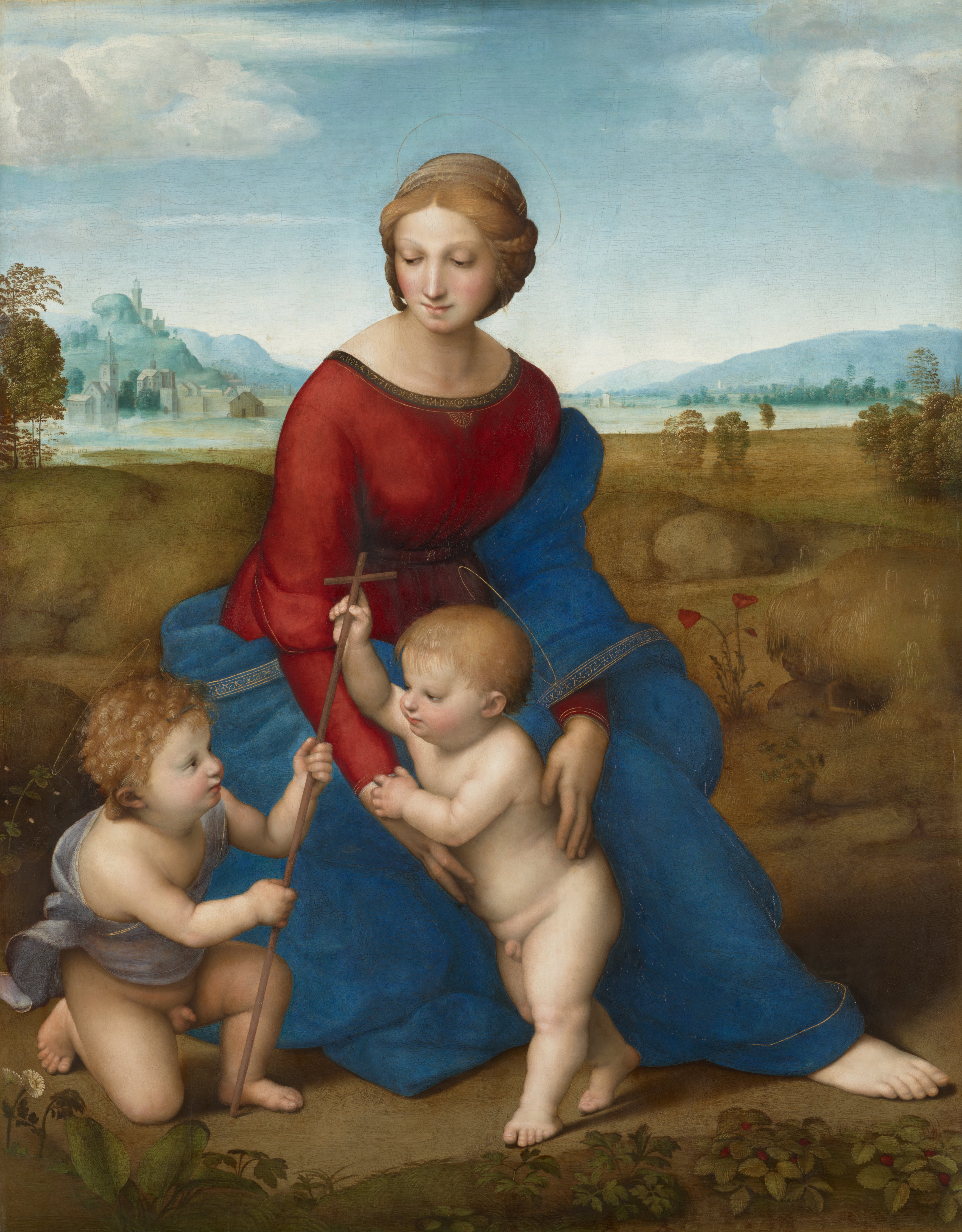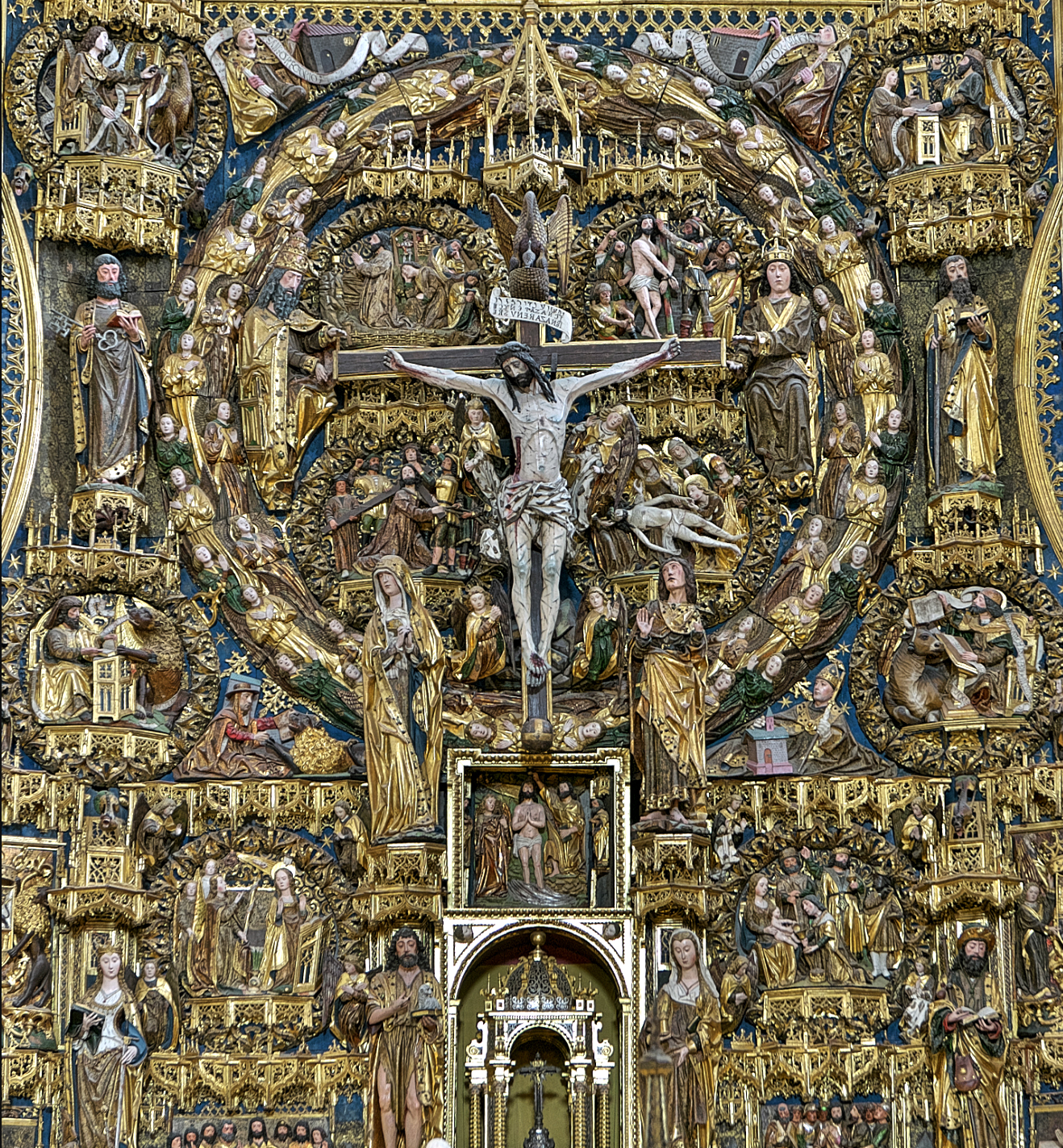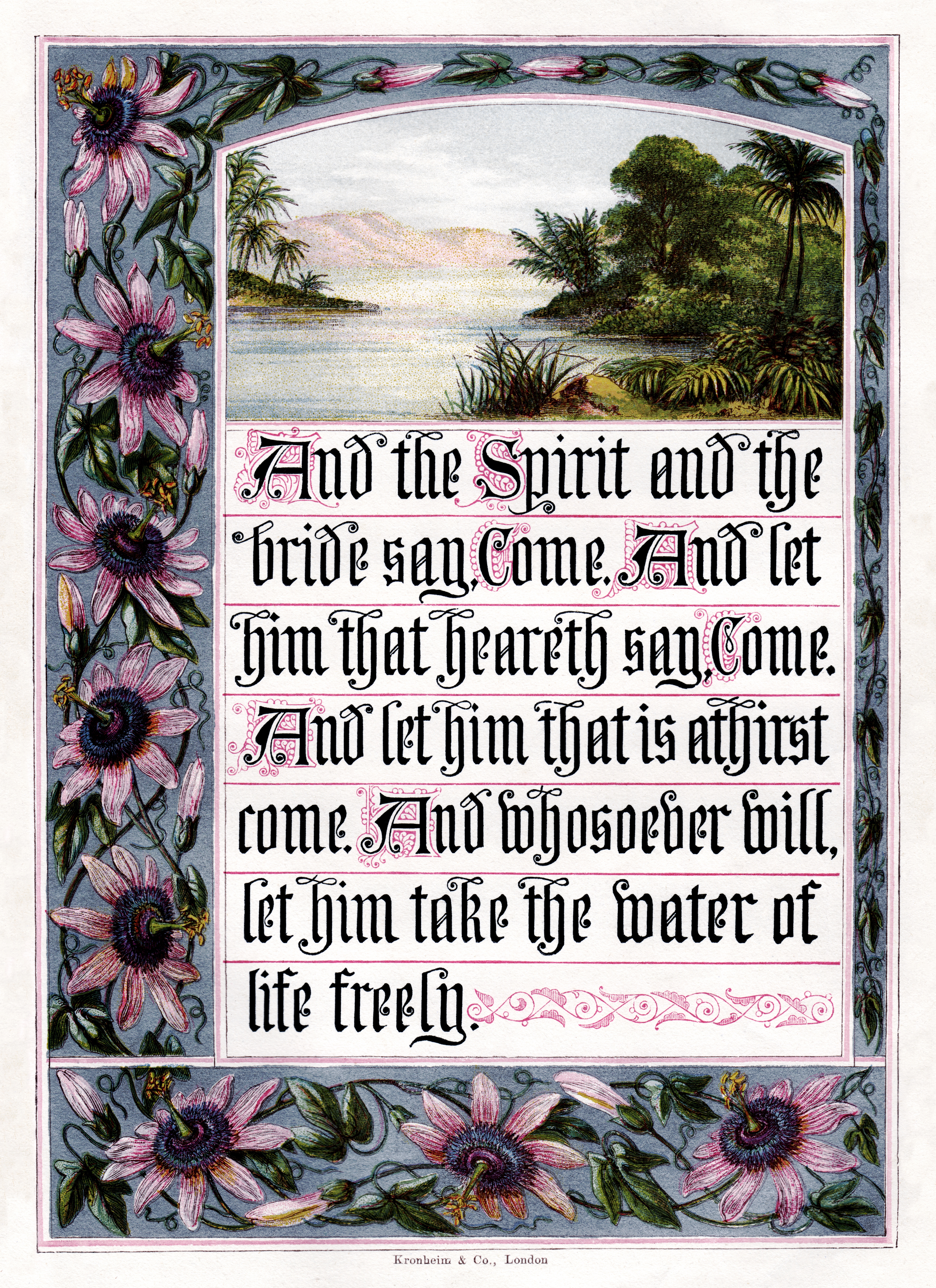|
Virgin And Child Enthroned
The ''Virgin and Child Enthroned'' (also known as the ''Thyssen Madonna'') is a small oil-on-oak panel painting dated 1433, usually attributed to the Early Netherlandish artist Rogier van der Weyden. It is closely related to his '' Madonna Standing'', completed during the same period. The panel is filled with Christian iconography, including representations of prophets, the Annunciation, Christ's infancy and resurrection, and Mary's Coronation. It is generally accepted as the earliest extant work by van der Weyden, one of three works attributed to him of the Virgin and Child enclosed in a niche on an exterior wall of a Gothic church. The panel is housed in the Museo Thyssen-Bornemisza in Madrid. The panel seems to be the left-hand wing of a dismantled diptych, perhaps with the ''Saint George and the Dragon'' panel now in the National Gallery of Art, Washington, D.C. As an early van der Weyden, it takes influence from Robert Campin and Jan van Eyck. Van der Weyden served his a ... [...More Info...] [...Related Items...] OR: [Wikipedia] [Google] [Baidu] |
Rogier Van Der Weyden
Rogier van der Weyden () or Roger de la Pasture (1399 or 140018 June 1464) was an early Netherlandish painter whose surviving works consist mainly of religious triptychs, altarpieces, and commissioned single and diptych portraits. He was highly successful in his lifetime; his paintings were exported to Italy and Spain, and he received commissions from, amongst others, Philip the Good, Netherlandish nobility, and foreign princes. By the latter half of the 15th century, he had eclipsed Jan van Eyck in popularity. However his fame lasted only until the 17th century, and largely due to changing taste, he was almost totally forgotten by the mid-18th century. His reputation was slowly rebuilt during the following 200 years; today he is known, with Robert Campin and van Eyck, as the third (by birth date) of the three great Early Flemish artists (''Vlaamse Primitieven'' or "Flemish Primitives"), and widely as the most influential Northern painter of the 15th century. Very few details of ... [...More Info...] [...Related Items...] OR: [Wikipedia] [Google] [Baidu] |
Gothic Architecture
Gothic architecture (or pointed architecture) is an architectural style that was prevalent in Europe from the late 12th to the 16th century, during the High and Late Middle Ages, surviving into the 17th and 18th centuries in some areas. It evolved from Romanesque architecture and was succeeded by Renaissance architecture. It originated in the Île-de-France and Picardy regions of northern France. The style at the time was sometimes known as ''opus Francigenum'' (lit. French work); the term ''Gothic'' was first applied contemptuously during the later Renaissance, by those ambitious to revive the architecture of classical antiquity. The defining design element of Gothic architecture is the pointed or ogival arch. The use of the pointed arch in turn led to the development of the pointed rib vault and flying buttresses, combined with elaborate tracery and stained glass windows. At the Abbey of Saint-Denis, near Paris, the choir was reconstructed between 1140 and 1144, draw ... [...More Info...] [...Related Items...] OR: [Wikipedia] [Google] [Baidu] |
Museo Del Prado
The Prado Museum ( ; ), officially known as Museo Nacional del Prado, is the main Spanish national art museum, located in central Madrid. It is widely considered to house one of the world's finest collections of European art, dating from the 12th century to the early 20th century, based on the former Spanish royal collection, and the single best collection of Spanish art. Founded as a museum of paintings and sculpture in 1819, it also contains important collections of other types of works. The Prado Museum is one of the most visited sites in the world, and is considered one of the greatest art museums in the world. The numerous works by Francisco Goya, the single most extensively represented artist, as well as by Hieronymus Bosch, El Greco, Peter Paul Rubens, Titian, and Diego Velázquez, are some of the highlights of the collection. Velázquez and his keen eye and sensibility were also responsible for bringing much of the museum's fine collection of Italian masters to Spain, ... [...More Info...] [...Related Items...] OR: [Wikipedia] [Google] [Baidu] |
Durán Madonna
''Durán Madonna'' (also known as the ''Madonna in Red'' or ''Virgin and Child in a Niche'' or ''Madonna Enthroned'') is an oil on oak panel painting completed sometime between 1435 and 1438 by the Netherlandish painter Rogier van der Weyden. The painting derives from Jan van Eyck's ''Ince Hall Madonna'' and was much imitated subsequently.Panofsky p. 259 Now in the Prado, Madrid, it depicts a seated and serene Virgin Mary dressed in a long, flowing red robe lined with gold-coloured thread. She cradles the child Jesus who sits on her lap, playfully leafing backwards through a holy book or manuscript on which both figures' gazes rest. But unlike van Eyck's earlier treatment, van der Weyden not only positions his Virgin and Child in a Gothic apse or niche as he had his two earlier madonnas (the '' Madonna Standing'' and the ''Virgin and Child Enthroned''), but also places them on a projecting plinth, thus further emphasising their sculptural impression. Christ appears much older t ... [...More Info...] [...Related Items...] OR: [Wikipedia] [Google] [Baidu] |
Kunsthistorisches Museum
The Kunsthistorisches Museum ( "Museum of Art History", often referred to as the "Museum of Fine Arts") is an art museum in Vienna, Austria. Housed in its festive palatial building on the Vienna Ring Road, it is crowned with an octagonal dome. The term ''Kunsthistorisches Museum'' applies to both the institution and the main building. It is the largest art museum in the country and one of the most important museums worldwide. Emperor Franz Joseph I of Austria-Hungary opened the facility around 1891 at the same time as the Natural History Museum, Vienna which has a similar design and is directly across Maria-Theresien-Platz. The two buildings were constructed between 1871 and 1891 according to plans by Gottfried Semper and Baron Karl von Hasenauer. The emperor commissioned the two Ringstraße museums to create a suitable home for the Habsburgs' formidable art collection and to make it accessible to the general public. The buildings are rectangular in shape, with symmetrical ... [...More Info...] [...Related Items...] OR: [Wikipedia] [Google] [Baidu] |
Gothic Sculpture
Gothic sculpture was a sculpture style that flourished in Europe during the Middle Ages, from about mid-12th century to the 16th century,The chronology of the period varies significantly according to the source consulted evolving from Romanesque art, Romanesque sculpture and dissolving into Sculpture in the Renaissance period, Renaissance sculpture and Mannerism."Gothic art" In: '':pt:Encyclopædia_Britannica, Encyclopædia Britannica Online'' When the Classicism, classical values started to be appreciated again in the Renaissance, the sculpture from the previous centuries was seen as shapeless and rough and was given the name of Gothic, since it was believed to come from the culture of the Goths, people considered barbaric and supposedly responsible for the disappearance of the Roman Empire. [...More Info...] [...Related Items...] OR: [Wikipedia] [Google] [Baidu] |
Marian Blue
Marian blue is a tone of the color ultramarine named for its use with the Virgin Mary. Background In paintings, Mary is traditionally portrayed in blue. This tradition can trace its origin to the Byzantine Empire, from circa 500 AD, where blue was "the color of an empress". A more practical explanation for the use of this color is that in Medieval and Renaissance Europe, the blue pigment was derived from the rock lapis lazuli, a stone imported from Afghanistan of greater value than gold. Beyond a painter's retainer, patrons were expected to purchase any gold or lapis lazuli to be used in the painting. Hence, it was an expression of devotion and glorification to swathe the Virgin in gowns of blue. Transformations in visual depictions of the Virgin from the 13th to 15th centuries mirror her "social" standing within the Church as well as in society. In art the association of blue with Mary was complemented by an association of red with Jesus. The juxtaposition of the two is an imp ... [...More Info...] [...Related Items...] OR: [Wikipedia] [Google] [Baidu] |
Bride Of Christ
The bride of Christ or the lamb's wife is a term used in reference to a group of related verses in the Bible, in the Gospels, Revelation, the Epistles and related verses in the Old Testament. Sometimes, the bride is implied by calling Jesus a bridegroom. For over 1500 years, the Church was identified as the bride betrothed to Christ. However, there are instances of the interpretation of the usage varying from church to church. Most believe that it always refers to the church. Christ as a bridegroom In the Gospel of John, John the Baptist speaks of Jesus Christ as the bridegroom and mentions the bride. That is the only place in the Gospels that the bride is mentioned, but because a bridegroom must have a bride, all other mentions of the bridegroom imply the bride. In the Gospels, when Jesus is asked why his disciples do not fast, but the followers of John and the Pharisees do, Jesus answers: In , and , the Apostles are referred to as the friends, guests, or children dep ... [...More Info...] [...Related Items...] OR: [Wikipedia] [Google] [Baidu] |
Queen Of Heaven
Queen of Heaven ( la, Regina Caeli) is a title given to the Virgin Mary, by Christians mainly of the Catholic Church and, to a lesser extent, in Anglicanism, Lutheranism, and Eastern Orthodoxy. The Catholic teaching on this subject is expressed in the papal encyclical ''Ad Caeli Reginam'', issued by Pope Pius XII in 1954. It states that Mary is called Queen of Heaven because her son, Jesus Christ, is the king of Israel and the heavenly king of the universe; indeed, the Davidic tradition of Israel recognized the mother of the king as the queen mother of Israel. The title "Queen of Heaven" has long been a Catholic tradition, included in prayers and devotional literature and seen in Western art in the subject of the Coronation of the Virgin from the High Middle Ages, long before it was given a formal definition status by the Church. Theological basis Queen of Heaven ( la, Regina Caeli) is one of many Queen titles used of Mary, mother of Jesus. The title derived in part from the ... [...More Info...] [...Related Items...] OR: [Wikipedia] [Google] [Baidu] |
Swaddling
Swaddling is an age-old practice of wrapping infants in blankets or similar cloths so that movement of the limbs is tightly restricted. Swaddling bands were often used to further restrict the infant. Swaddling fell out of favour in the 17th century. A few authors are said to be of the opinion that swaddling is becoming popular again, although medical and psychological opinion on the effects of swaddling is largely against. Some modern medical studies indicate that swaddling helps babies fall asleep and to remain asleep and helps to keep the baby in a supine position, which lowers the risk of sudden infant death syndrome (SIDS). However, another study indicated that swaddling increased the risk of SIDS. Additionally, emerging evidence is showing that certain swaddling techniques may increase the risk of developmental dysplasia of the hip. Origin and history Several authors presume that swaddling was invented in the paleolithic period. The earliest depictions of swaddled bab ... [...More Info...] [...Related Items...] OR: [Wikipedia] [Google] [Baidu] |
Nursing Madonna
The Nursing Madonna, ''Virgo Lactans'', or Madonna Lactans, is an iconography of the Madonna and Child in which the Virgin Mary is shown breastfeeding the infant Jesus. In Italian it is called the ''Madonna del Latte'' ("Madonna of milk"). It was a common type in painting until the change in atmosphere after the Council of Trent, in which it was rather discouraged by the church, at least in public contexts, on grounds of propriety. The depiction is mentioned by Pope Gregory the Great, and a mosaic depiction probably of the 12th century is on the facade of Santa Maria in Trastevere in Rome, though few other examples survive from before the late Middle Ages. It continued to be found in Orthodox icons (as ''Galaktotrophousa'' in Greek, ''Mlekopitatelnitsa'' in Russian), especially in Russia. Usage of the depiction seems to have revived with the Cistercian Order in the 12th century, as part of the general upsurge in Marian theology and devotion. Milk was seen as "processed blood", a ... [...More Info...] [...Related Items...] OR: [Wikipedia] [Google] [Baidu] |
Robert Campin - The Virgin And Child Before A Firescreen (National Gallery London)
The name Robert is an ancient Germanic given name, from Proto-Germanic "fame" and "bright" (''Hrōþiberhtaz''). Compare Old Dutch ''Robrecht'' and Old High German ''Hrodebert'' (a compound of '' Hruod'' ( non, Hróðr) "fame, glory, honour, praise, renown" and ''berht'' "bright, light, shining"). It is the second most frequently used given name of ancient Germanic origin. It is also in use as a surname. Another commonly used form of the name is Rupert. After becoming widely used in Continental Europe it entered England in its Old French form ''Robert'', where an Old English cognate form (''Hrēodbēorht'', ''Hrodberht'', ''Hrēodbēorð'', ''Hrœdbœrð'', ''Hrœdberð'', ''Hrōðberχtŕ'') had existed before the Norman Conquest. The feminine version is Roberta. The Italian, Portuguese, and Spanish form is Roberto. Robert is also a common name in many Germanic languages, including English, German, Dutch, Norwegian, Swedish, Scots, Danish, and Icelandic. It can be use ... [...More Info...] [...Related Items...] OR: [Wikipedia] [Google] [Baidu] |
_Detail2.jpg)
.jpg)
.jpg)





